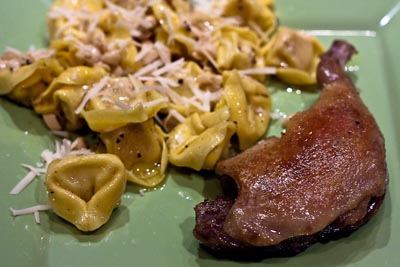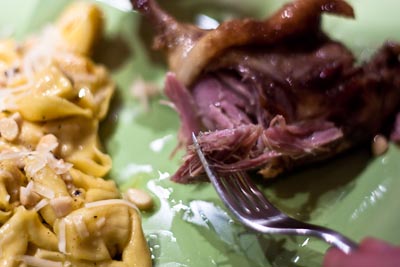Anyone who’s read this blog already knows how I feel about duck. And if you aren’t one of those people, know this - I’m kind of infatuated with it. That wonderfully flavorful dark meat surrounded by a thick layer of fat that, when properly prepared, becomes a crisp layer of duck crackin’ over a thin and lusciously smooth layer of interior fat is enough to make me order it anytime I see it on a restaurant menu. In the past I’ve seared it and cured it. This week, I decided to confit it.

Confitting originally came about as a preservation method. First the meat is salted and allowed to sit for a day or two. Then the salt is rinsed off and the meat is cooked very slowly in fat over low heat. At that point, it can be cooled down and stored in a low-temperature environment, immersed in fat (which of course, keeps the meat out of contact with the air) for months. When it’s time to eat the confitted meat, it is brought to room temperature, removed from the fat, and crisped up on the stove top or in the oven.
These days, confit is more about flavor than having enough meat to last you through the winter. With the advent of refrigeration, these old-school preservation methods are no longer strictly required. However, the taste of confitted duck legs makes it well worth the effort.
Even if you generally don’t like duck, it may be worth your while to try duck confit. I’ve eaten it in restaurants before and always been enamored with the flavor and texture of the meat. My favorite versions have a taste that screams “I’ve been in close contact with an unholy amount of garlic for a very long while!!” The flesh takes on a velvety texture, and with the help of salt and garlic (and whatever other flavorings strike the cook’s fancy), the best parts of the duck’s flavor are amplified and accentuated.
I loosely followed the confitting method outlined in Michael Ruhlman and Brian Polcyn’s book, Charcuterie: The Craft of Salting, Smoking, and Curing
And yet, even with these little indiscretions, they came out wonderfully.

Here’s the method I used:
First, I took the pair of duck legs and thoroughly washed and dried them. Next, I placed them in a shallow glass dish and swathed them in salt, crushed bay leaves, crushed and sliced garlic, and freshly cracked pepper. Next, they were covered in plastic wrap and chucked into the refrigerator for what turned into 48 hours (my intention had been to leave them only 24-hours, but timing became a factor).
Next, the duck legs were rinsed completely of their salt and other flavorings, patted dry with paper towels, and placed in the smallest heavy pot that would still hold them comfortably. I poured olive oil over the legs till they were completely submerged, and heated them on the stove top over medium-high heat till they were at a bare simmer. Very, very carefully, this pot of simmering oil and duck legs was moved to a 200 degree (F) oven to slowly cook for about 6 hours.
After the oven time was finished, the duck legs were removed from the fat and sauteed, skin-side down in a heated skillet. Finally, they were plopped artfully on a plate with some store-bought pumpkin tortellini and consumed with much ardor and unfortunate haste.
Another suggestion in Charcuterie is to purchase a whole duck and render the necessary fat yourself. For the amount of money I’d have spent on two duck legs and a tub of fat, I can have a whole duck which would provide the legs and fat plus the breasts and thighs (gawd what kinda search traffic is this gonna garner) and a carcass for making stock. That’s my master plan for Round 2 of this Duck Confit challenge. I promise I’ll do it right next time.